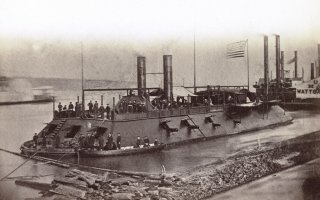Why the American Civil War Was the First Truly Modern Conflict
A plethora of new advances were introduced that changed warfare forever.
Here's What You Need to Know: The American Civil War foreshadowed the industrial era (and European military observers knew it).
It was one of the bloodiest conflicts of the era, and arguably the first “modern war.” It saw a wave of new innovations including modernized warships, the use of aerial observation, more rapid firing small arms and even submarines. If this sounds like the First World War that would be incorrect.
The American Civil War was truly the first modern war and a plethora of new advances were introduced and changed warfare forever.
The Telegraph and Railroad
Prior to the Civil War communications could take days, even weeks to travel only few hundred miles, but that began to change as the telegraph provided vital tactical, operational and strategic communications. Its use has been credited as a contributor to the Union victory. During the war the United States Military Telegraph Service (USMT) handed some 6.5 million messages and laid some 15,000 miles of telegraph lines.
Likewise, the American Civil War was the first conflict in which railroads also provide to be a major factor. In the years leading up to the war, the Northern states laid around 22,000 miles while the South had laid 9,500 miles. The use of railroads on both sides became critically important in transporting men and material.
Iron Ships and Submarines
While the European powers—notably France the United Kingdom—had developed modern naval warships or so-called “ironclads” before the outbreak of the Civil War, it was in the waters off the coast of Virginia where the warships first engaged in combat. After the Civil War, naval warfare never went back to wooden sailing ships and the latter half of the nineteenth-century saw a naval arms race as ships became larger and more heavily armed.
The War Between the States also saw one of the first successful uses of a submarine. The CSN Hunley was essentially an iron tomb for the eight man crew, but it became the first submarine to successfully sink an enemy warship when it was used to successfully deploy a mine on the USS Housatonic.
Rapid Fire Weapons
It is correct that the First World War was the first large scale conflict to see the use of machine guns, but it was the Civil War some fifty years earlier that introduced modern firearms. Muzzle loading firearms gave way to breach-loading repeating rifles, while the Gatling Gun was employed in small numbers.
Fifty years before the Civil War, armies fought with weapons little improved from those employed for well over a century. But fifty years after the Civil War, rapid fire machines changed the concept of war. It was on the terrible and bloody battlefields of conflict that a small arms revolution took place.
Aerial Observation
The American Civil War was fought four decades before the Wright Brothers successfully conducted the first powered flight, but the war is notable for the use of observation balloons, which allowed both sides to monitor enemy troop movements and to direct artillery fire. U.S. Army aviation can also trace its origins back to those hydrogen-filled balloons.
Moreover, both sides had reportedly considered powered flying machines—precursors to the airplane. Nothing came of these efforts, but it is clear that even before the word “airplane” entered in the vernacular forward thinking military planners were already considering how such a weapon could be employed.
Photography
Photographic images of earlier conflicts exist, notably the Crimean War, but it was the American Civil War that is considered to be the first major conflict to be so extensively photographed. Studio owner Mathew Brady is usually credited with most of the photographs taken, but it was Alexander Gardner and his team—working for Brady—who actually took most of the photos.
The use of photographs chronicled the conflict in a way unlike any prior conflict. It allowed a greater understanding of what it was actually like in the field. While painters still traveled along with the armies, few paintings of any battle had shown the bloated corpses or the other horrors of war that photographs provided.
Peter Suciu is a Michigan-based writer who has contributed to more than four dozen magazines, newspapers and websites. He regularly writes about military small arms, and is the author of several books on military headgear including A Gallery of Military Headdress, which is available on Amazon.com.
This article first appeared in February 2021.
Image: Wikimedia Commons

